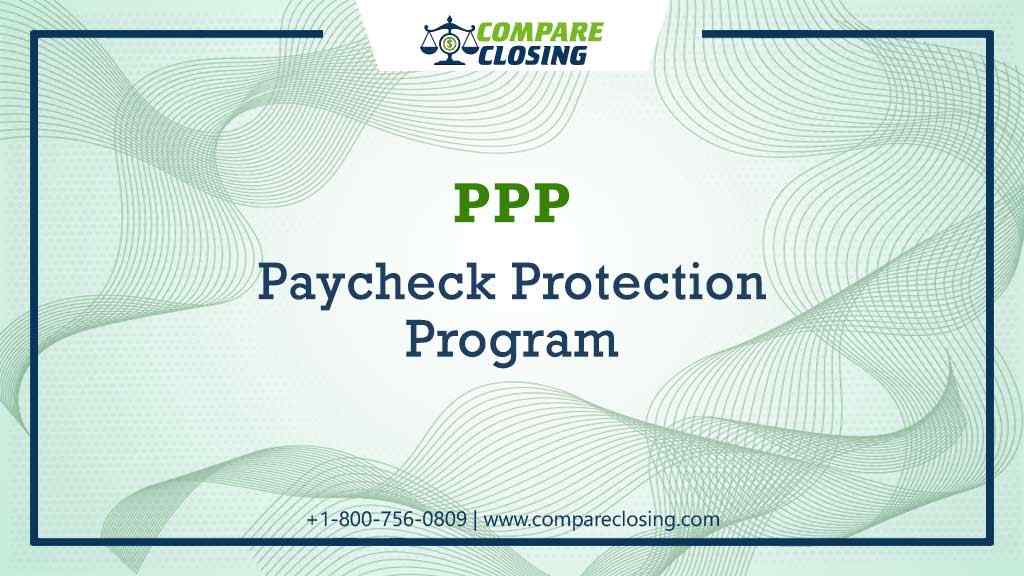Table of Contents
- What Are Netting Escrows & How Does It Work?: The Best Guide - January 2, 2024
- The Secret About Prescriptive Easement: Top Guide 1 Must Know - December 4, 2023
- About Home Equity Loans In Texas And How Can One Obtain It - November 27, 2023
What is the Paycheck Protection Program?
Paycheck Protection Program initially was a $350-billion program built with the intention of providing American small businesses with eight weeks of monetary assistance through 100 % federally guaranteed loans.
The PPP loans are supported by the Small Business Administration (SBA). A loan program was originated on December 27, 2020, by the U.S. federal government signing a new bill into law from the Coronavirus Aid, Relief, and Economic Security (CARES) Act, and it was called the Paycheck Protection Program.
In late April, the program was expanded by the Paycheck Protection Program and Health Care Enhancement Act with additional funding of $310 billion.
Important changes to the program were made by the Paycheck Protection Program Flexibility Act allowing more time to utilize the funds, and making it easier to get a loan fully forgiven.
A second stimulus package was then signed on December 27, 2020, into law and the program got a topping of an additional $285 billion in funding and updating the eligible expenses.
A second PPP loan for businesses opened up that used up their first PPP loan and have experienced a 25% or greater reduction in revenue.
Highlights of PPP loan
- All small businesses qualify for the loan program
- The maturity rate of the loan is two years and the interest rate is 1%.
- Any loans made after June 5, 2020, have a length of five years.
- Starting from the loan disbursement date the loan covers expenses for 24 weeks.
- One needs to make loan payments until either the forgiveness application is processed, or 10 months after the end of the borrower’s 24-week covered period
- The borrower does not need collateral or personal guarantees
- No fees
- The loan can be forgiven and can turn into a non-taxable grant
Who is Eligible for a PPP loan?
- Compared to SBA disaster loans, Paycheck Protection Program loans are farther reaching. If one is a small business owner, sole proprietors, independent contractors, and self-employed individuals all are eligible for a PPP loan.
- A Schedule C needs to be submitted by sole proprietorships from their filed or to be filed tax return showing the net profit from the sole proprietorship.
- Along with their Schedule C, independent contractors will need to submit Form 1099-MISC.
- A payroll tax filings reported to the Internal Revenue Service need to be submitted by self-employed individuals.
A key qualification was introduced for second draw PPP loans in 2021. If businesses were looking to apply for their second PPP loan they would need to show a 25% or greater reduction in their revenue.
This can be shown by comparing revenue between any quarter in 2020 with the same quarter of the previous year.
For instance, if a business recorded $20,000 of sales revenue in the second quarter of 2019. They qualify for PPP funding if in Q2 2020 they recorded $15,000 of sales revenue or less.
How is the PPP loan to be used?
A minimum of 60 % of the PPP loan should be used to fund payroll and employee benefits costs.
The balance of 40 % can be spent:
- For paying mortgage interest
- For making rent and lease payments
- For utilities
- For using in operations expenditures like software and accounting needs
- Property damage costs because of public disturbances that are not covered by insurance
- Supplier costs like cost of goods sold
- Expenditures for worker protection to be COVID compliant
If these guidelines are followed strictly the borrower will be able to have 100% of the loan forgiven. If the borrower does not spend the funds in the right way as certified during the time of application they could be charged with fraud.
What all are included in payroll costs?
In the case of a sole proprietor or independent contractor, the salary, wages, commissions, tips, bonuses, and hazard pay which is rounded off at a $100,000 annual basis for each employee are all considered as payroll costs under the PPP program.
Also, employee benefits like costs for vacation, parental, family, medical, or sick leave allowance for separation or dismissal, payments required for the provisions of group health care benefits like insurance premiums, and payment of any retirement benefit are all considered as payroll costs under the PPP program
On compensation, State and local taxes assessed
What is not included in payroll costs?
Any payments that are done to independent contractors
S corps and C corps owners who aren’t on payroll, under this program shareholders distributions are not counted as payroll
The process to apply for a PPP loan
The SBA does not lend the money directly, they simply back the loan provided by the lender.
As part of their application, the borrower will be asked to verify a couple of things like:
Their current economic uncertainty because of which the loan is necessary to support their ongoing operations.
The funds from the loan will be used either to retain workers and maintain payroll or to make the mortgage, lease, and utility payments and not other things.
Provide documents that verify the total number of full-time equivalent employees on payroll and the dollar amounts of payroll costs, the borrower’s covered mortgage interest payments, their covered rent payments, and after getting this loan covered utilities for the 24 weeks.
The lender will calculate the eligible loan amount using the tax documents submitted. They need to affirm that the tax documents are identical to those submitted to the IRS.
If the borrowers are applying for their second draw PPP loan, they have already used up the funds from their first draw PPP loan.
What is the financial documentation needed for a PPP loan?
- The borrower needs to provide payroll/bookkeeping records to prove their payroll expenses.
- They need to provide payroll processor records
- Their payroll tax filings
- Forms 941, 940, and W-3 which will be their payroll tax forms from 2019 or 2020
- Records of Form 1099-MISC
- Schedule C for a sole proprietorship
The easiest way to get the financial information is by downloading a payroll report through their payroll provider.
If the borrower is self-employed and doesn’t have a completed Schedule C to submit, they will need to get retroactive bookkeeping to calculate their net profit for their Schedule C.
Their PPP loan amount will depend on how accurate their net profit is.
If borrowers have more than one business they might have difficulty getting relief funding because their businesses don’t have cleanly separated finances.
It’s important to get separate bookkeeping done for each business if there is more than one business.
This will be more important especially when there comes a time to prove the expenses for loan forgiveness.
The procedure to apply for PPP loan forgiveness
- In 24 weeks after the loan signing date, all expenses related to the following can be forgiven:
- Individual compensation is set at $100,000 annualized that could include payroll—salary, wage, vacation, parental, family, medical, or sick leave, health benefits, bonuses, hazard pay.
- If the mortgage was signed before February 15, then mortgage interest
- If the lease agreement was in effect before February 15, 2020, then rent
- Utilities if he service began before February 15, 2020
- All software, cloud computing, or other human resources and accounting needs will be considered as operations expenditures and can be forgiven.
- Any costs from damages to the property because of public disturbances occurring in 2020 and if it is not covered by insurance.
- Any purchase order or order of goods made prior to receiving a PPP loan essential to operations will be considered as supplier cost and can be forgiven.
- Any personal protection equipment or property improvements to remain COVID compliant from March 1, 2020, onwards will be considered as worker protection expenditures.
The borrower needs to have accurate bookkeeping to prove their expenditure during the loan period.
To qualify for forgiveness of the full loan, they must have spent 60% of the loan on the payroll.
When the covered period is up or the PPP funds are all spent, the borrower can apply for forgiveness through their lender. Which is being handled through online portals.
Once the lender receives the application, they make a decision within 60 days.
The motive of the Paycheck Protection Program is to protect paychecks. The borrower must maintain an average monthly number of full-time equivalent employees who are equal to or above that they had the previous year.
And 60% of the loan funds must be spent on payroll.
When will the amount that can be forgiven will be reduced.
If there is any reduction in the number of employees retained then the amount that can be forgiven will be reduced in proportion to that.
It would reduce if any wages were reduced by more than 25%.
If the borrower rehires employees who were laid off at the beginning of the period or restores any reduction in salary that was made at the beginning of the period, they will not be penalized for having a reduction in employees or wages.
For loans that were received in 2020, the deadline was December 31, 2020. The deadline for loans received in 2021, is the end of the covered period.
Conclusion
During the pandemic, the federal Paycheck Protection Program provided more than $800 billion in forgivable loans to U.S. businesses.
SBA has given the responsibility of the process of PPP applications to the community banks and lending institutions to process the loan applications and distribute the money.
During the pandemic, PPP loans were designed to help small businesses continue paying expenses for employees and other costs.
If the money was shown to be used for the purposes outlined in the PPP application then loans are forgiven.
Amanda Byford
Amanda Byford has bought and sold many houses in the past fifteen years and is actively managing an income property portfolio consisting of multi-family properties. During the buying and selling of these properties, she has gone through several different mortgage loan transactions. This experience and knowledge have helped her develop an avenue to guide consumers to their best available option by comparing lenders through the Compare Closing business.





